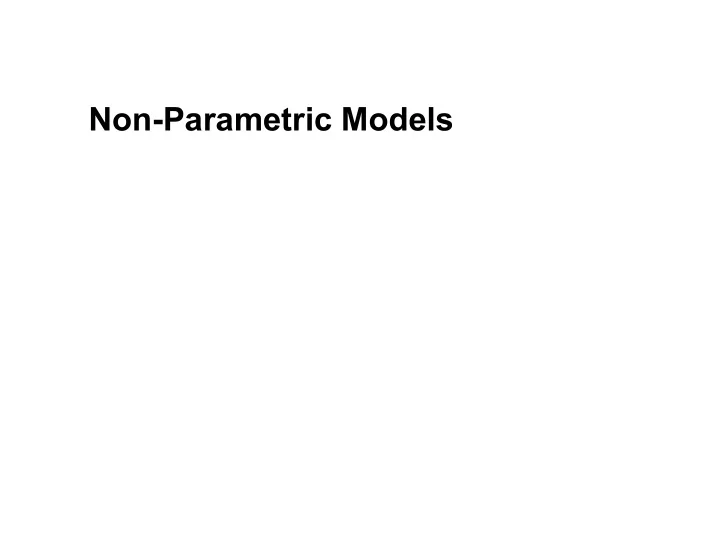

Non-Parametric Models
Review of last class: Decision Tree Learning • dealing with the overlearning problem: pruning • ensemble learning • boosting
Agenda • Nearest neighbor models • Finding nearest neighbors with kd trees • Locality-sensitive hashing • Nonparametric regression
Non-Parametric Models • doesn’t mean that the model lacks parameters • parameters are not known or fixed in advance • make no assumptions about probability distributions • instead, structure determined from the data
Comparison of Models Parametric Non-Parametric • data summarized by a • data summarized by an fixed set of parameters unknown (or non-fixed) set of parameters • once learned, the original data can be • must keep original data discarded to make predictions or to update model • good when data set is relatively small – avoids • may be slower, but overfitting generally more accurate • best when correct parameters are chosen!
Instance-Based Learning Decision Trees • examples (training set) described by: • input: the values of attributes • output: the classification (yes/no) • can represent any Boolean function
Another NPM approach: Nearest neighbor (k-NN) models • given query x q • answer query by finding the k examples nearest to x q • classification: • take plurality vote (majority for binary classification) of neighbors • regression • take mean or median of neighbor values
Example: Earthquake or Bomb?
Modeling the data with k-NN k = 1 k = 5
Measuring “nearest” • Minkowski distance calculated over each attribute (or dimension) i p ) 1/ p L p ( x j , x q ) = ( ∑ | x j , i − x q , i | i • p = 2: Euclidean distance – typically used if dimensions measure similar properties (e.g., width, height, depth) • p = 1: Manhattan distance – if dimensions measure dissimilar properties (e.g., age, weight, gender)
Recall a problem we faced before • shape of the data looks very different depending on the scale • e.g., height vs. weight, with height in mm or km • similarly, with k-NN, if we change the scale, we’ll end up with different neighbors
Simple solution • simple solution is to normalize: x ' ( x µ / ) = − σ j,i j,i i i
Example: Density estimation x x smallest circles enclosing 10 neighbours 128-point sample MoG representation
Density Estimation using k-NN • # of neighbours impacts quality of estimation ground k=3 k=10 k=40 truth
Curse of dimensionality • we want to find k = 10 nearest neighbors among N=1,000,000 points of an n-dimensional space • sounds easy, right? • volume of neighborhood is k/N • average side length l of neighborhood is (k/N) 1/n n l 1 .00001 2 .003 3 .002 10 .3 20 .56
k-dimensional (kd) trees • balanced binary tree with arbitrary # of dimensions • data structure that allows efficient lookup of nearest neighbors (when # of examples >> k) • recursively divides data into left and right branches based on value of dimension i
k-dimensional (kd) trees • query value might be on left half of divide but have some of k nearest neighbors on right half • decide whether to inspect the right half based on distance of best match found from dividing hyperplane
Locality-Sensitive Hashing (LSH) • uses a combination of n random projections, built from subsets of the bit-string representation of each value • value of each of the n projections stored in the associated hash bucket
Locality-Sensitive Hashing (LSH) • on search, the set of points from all hash buckets corresponding to the query are combined together • then measure distance from query value to each of the returned values • real-world example: • data set of 13 million samples of 512 dimensions • LSH only needs to examine a few thousand images • 1000-fold improvement over kd trees!
Nonparametric Regression Models • Let’s see how different NPM strategies fare on a regression problem
Piecewise linear regression
3-NN Average
Linear regression through 3-NN
Local weighting of data with kernel 1 0.5 0 -10 -5 0 5 10 quadratic kernel with k = 10:
Locally weighted quadratic kernel k=10
Comparison connect the 3-NN average dots locally weighted regression 3-NN linear (quadratic kernel width k=10) regression
Next class • Statistical learning methods, Ch. 20
Recommend
More recommend